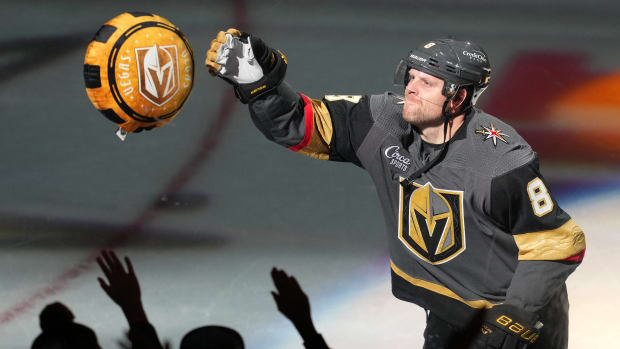Phil Kessel is my favorite player. Always has been. Always will be.
Kessel is the influence behind the Twitter handle that I can now never change, why I willfully forked over the extra fee out of my allowance to pay for a custom-made No. 81 jersey on every minor hockey team I played for as a kid and why I compulsively practised my wrist shot for countless hours in my childhood home’s driveway in order to develop a “Kessel-like” release.
It never came. But if my parents ever decide to re-paint their garage to cover up the puck marks, Kessel will be receiving the bill.
He was simply the coolest hockey player I’d ever seen when he arrived in Toronto back in 2009. And now, all these years later, Kessel is still just as cool as ever. It’s not a secret anymore.
Ever since Kessel set the NHL’s ironman record on Wednesday night, stories relating to his off-ice quirks and truly unique personality have dominated headlines across the hockey world, and for good reason. The guy is an enigma. A one-of-a-kind figure who has defied the typical hockey mold to great success and marches exclusively to the beat of his own drum.
In an era defined by players with Greek God physiques and veritable teams of dieticians and nutritionists employed to regulate each morsel of food that goes into their bodies, Kessel is the one who has managed to stay healthier than the rest.
Kessel, the guy who looks like a pipe fitter on his last week before retirement, who apparently didn’t drink water for most of his early-career tenure in Boston because he hated the taste and whose atypical physique inspired a Toronto reporter to fabricate a story about Kessel’s addiction to hot dogs in an attempt to criticize his conditioning.
It didn’t work. And now, Kessel is the most durable player in NHL history, never missing a day of work at any point over the past 13 years. I doubt anyone who has ever questioned his commitment to the game can say the same.
Kessel has beaten cancer. As a teenager, he missed just 11 total NHL games while undergoing treatment and, eventually, surgery for testicular cancer, and came back stronger than ever to win the Bill Masterton Trophy.
The lengths to which a player in this day and age must go to avoid the typical bumps and bruises that cause even the NHL’s toughest players to sit out a night or two is unthinkable. Sure, Kessel isn’t the most physical player in the world, opting to use his skill and hockey sense rather than his body to influence play. But this is a game played on frozen water between two teams of jacked athletes wearing knives for shoes. At some point, accidents happen.
Not to Kessel, though. At least, he hasn’t let those accidents stop him from showing up day in and day out, remaining a productive offensive weapon deep into his 30s while playing in a league that skews younger by the season.
Kessel didn’t reach these unprecedented heights by being the stubborn, selfish player his critics painted him as. He’s modified his style of play to fit the needs of his team on several occasions, going from a top-line goal-scorer in Toronto, to a middle-six swiss army knife in Pittsburgh, to a veteran playmaking mentor in Arizona, all without so much as an inkling of unhappiness.
Not every player is willing or even capable of doing that – Kessel is.
Arriving in Toronto, Kessel was saddled with the distinction of the franchise’s savior and proceeded to become the franchise’s most consistent goal-scorer since Mats Sundin, shouldering the Maple Leafs’ entire offensive load during his tenure while also logging roughly 20 minutes per night.
In Pittsburgh, Kessel joined a team with its core group already intact. Deferring from his past position as the offensive focal point, Kessel assimilated seamlessly into the Penguins’ overall system while also tapping into his innate playmaking abilities, and ultimately became an MVP candidate for the first of the club’s two consecutive Stanley Cup victories. Frankly, he should have won the 2016 Conn Smythe. But two Cup rings will likely do.
And then in Arizona, amidst the chaos of the Coyotes’ countless off-ice disasters, ever-present regime change, and overall failure as an on-ice product, Kessel never took his foot off the gas, continuing his transition into a pass-first player while establishing himself as perhaps the most beloved person in the entire organization.
Playing through injuries and avoiding hockey’s typically unavoidable bumps and bruises may have kept Kessel on the ice for the past 13 years in a literal sense. But his self-awareness as a player and teammate, and his willingness to adapt to whichever situation he’s put in is what allowed him to stick around this long in the first place.
There may never be another player like Phil Kessel ever again. So, let’s not take a single second we have left with him for granted.




